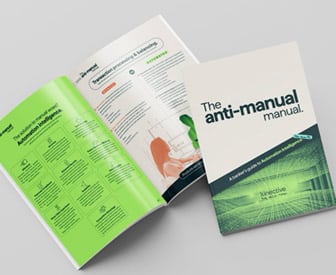The promise of artificial intelligence dominates technology strategy and planning in the banking industry.
But AI isn’t just about rolling out customer-facing tools like chatbots. AI also has immense potential in backend operations at financial institutions, according to Ron Shevlin, chief research officer at Cornerstone Advisors.
Generative AI can drive major productivity and efficiency gains by augmenting human capabilities in almost every department, empowering employees who do not work in customer-facing roles.
Shevlin stresses the urgent need to identify AI use cases beyond the marketing hype. From automated workflows to boosted creativity, financial leaders must search across the organization to uncover AI’s latent value, he argues in the following conversation with Jim Marous, founder and chief executive of the Digital Banking Report.

Accelerate Time-to-Market with Rapid Implementation
Create a sustainable competitive advantage with faster time to market by drastically reducing implementation time.
Read More about Accelerate Time-to-Market with Rapid Implementation

The New AI: A Banker’s Guide to Automation Intelligence
Manual tasks across channels is costly. And while AI is hot, there’s a simpler way to bring efficiency that many bankers have overlooked.
Read More about The New AI: A Banker’s Guide to Automation Intelligence
Banks and Credit Unions: Look Deeper for AI Use Cases
Q: Where is AI’s potential most overlooked within financial institutions today?
Ron Shevlin: Much focus centers on automating high-volume customer interactions like account opening. But AI’s potential reaches every function.
Until now, areas like compliance, legal, and IT thought they could gain little from “digital transformation.” ChatGPT and generative AI have changed all that and can finally bring these knowledge workers major productivity improvements, if leaders proactively identify opportunities beyond customer journeys.
How? Look across key workflows to pinpoint repetitive, manual processes that create friction. How much staff time is spent on tasks like copying data between systems, drafting rigid reports, searching records, or responding to routine queries? This is fertile ground for AI augmentation.
Likewise, examine pain points around information access and dissemination. Do people lack visibility into disparate systems? Does knowledge get siloed in individual inboxes and desktops? AI can provide connective tissue to break down these barriers.
Want to go deep on AI best practices for banks?
Attend our AI Masterclass — Unlocking the Power of Artificial Intelligence in Banking — at The Financial Brand Forum 2024 on May 20-22 in Las Vegas. Led by Ron Shevlin, chief research officer at Cornerstone, this three-hour workshop will be jam-packed with lessons learned from industry leaders and real-world case studies.
For more information and to register, check out the Forum website.
Q: What are some examples of AI driving gains in these kinds of applications?
Shevlin: Some institutions already use these tools to update webpages in minutes rather than weeks. The AI handles tedious upfront legwork of selecting images, optimizing copy, and laying out elements to engage visitors. This frees the human web designer to focus on strategic creative direction versus repetitive production tasks.
Some HR teams leverage AI to source and engage talent on LinkedIn. A proactive bot identifies qualified candidates, reaches out to gauge interest, and sustains personalized conversations at scale to build the talent pipeline. It acts as a digital assistant, amplifying the recruiter’s effectiveness.
“AI’s potential reaches every function.”
Florida’s SouthState Bank simulated an AI-driven marketing effort for health savings accounts. The bot autonomously created personalized email offers tailored to individual recipients, iteratively A/B tested message variants to optimize response rates, adjusted incentive structures based on data, and theoretically raised $2 million in just 22 days — all without human involvement after initial programming.
No institutions currently deploy such unchecked AI directly with customers, given reliability concerns. But experiments like this show AI’s immense potential across the institution when thoughtfully guided by humans.
Read more: ChatGPT Will Become ‘ChatOMG!’ in 2024, Forrester Predicts
How Can AI Support Your Internal Teams?
Q: Beyond automating workflows, how else might AI extend and support human capabilities?
Shevlin: Enhancing creativity and innovation represents an enormous opportunity that is often overlooked or discounted. Generative models don’t replace human ingenuity but can offer prompts to spur new ideas and directions.
Personally, when I tell ChatGPT to outline articles “in the style of Ron Shevlin,” it obviously can’t replicate my voice. However, the models do produce novel concepts that trigger creative breakthroughs for me as a writer. AI becomes a “co-pilot” for unlocking latent human potential.
Similarly, data model conversions that might cost millions through consultants can be handled for thousands in ChatGPT. The AI meticulously translates data schemas orders of magnitude faster than humans could. This massively amplifies what organizations can achieve with the same resources.
“Personally, when I tell ChatGPT to outline articles ‘in the style of Ron Shevlin,’ it obviously can’t replicate my voice. However, the models do produce novel concepts that trigger creative breakthroughs for me as a writer.”
Contract analysis also represents a huge opportunity. Lawyers currently devote vast hours to manually reviewing agreements. AI can scan documents in bulk to flag risky clauses, extract key data, and summarize insights. This frees legal teams to focus on high-value advising versus repetitive drudgery. Compliance departments are buried in manual reporting. AI can digest regulations and produce required filings with just human review. For fraud and AML, it detects suspicious patterns at a massive scale, far surpassing manual oversight.
In IT, AI accelerates development by generating and validating code. It also continuously monitors system health to catch anomalies and prevent outages. One engineer can leverage GitHub Copilot to realize a productivity gain of five to 10 times.
The list goes on. But leaders must proactively hunt for these hidden gems rather than remain fixated on AI’s more prominent customer uses.
Q: What advice do you have for leaders trying to leverage AI’s potential inside their institutions in this way?
Shevlin: First, treat this evolution as augmenting workers rather than replacing jobs — at least for the next decade. Then, identify use cases throughout the organization, not just customer journeys. And pilot applications rigorously before going live.
Read more:
- The Best Way to Implement GenAI (and Avoid Random Acts of Digital)
- See all of our latest coverage of artificial intelligence

What Are the Risks of Deep AI for Financial Institutions?
Q: How can financial institutions minimize AI-associated risks in these often critical functions?
Shevlin: You must also proactively develop guardrails so that innovations enhance, rather than undermine, knowledge workers’ productivity and creativity. The most dangerous pitfall is blindly deploying AI without governance. Rigorously audit inputs and outputs to ensure recommendations align with ethics and compliance. Actively monitor for biases creeping into models.
“The most dangerous pitfall is blindly deploying AI without governance.”
Transparency is also critical. Document what data is used for what purposes so results remain explainable. Enable developers to fine-tune and override models. AI should never operate as an inscrutable black box.
Used judiciously, AI represents an evolutionary augmentation, not a threat. However, it requires proactive change management and upskilling to realize benefits while safeguarding institutions and staff. The time for reluctance and avoidance has passed.
Q: How can smaller institutions like community banks do all this amid tightening budgets?
Shevlin: The solution is partnerships. Pooling resources with industry peers spreads costs while still gaining capabilities. Vendor marketplaces also offer affordable pay-as-you-go access to the latest innovations.
Start small with limited pilots focused on specific pain points, then scale. Even large banks often underestimate how quickly productivity compounds from early AI wins. With the right strategy, organizations of any size can capitalize on AI’s potential.
Prefer listening?
- Webinar: A Marketer’s Guide to AI and Banking
- Podcast: How Generative AI Will Revolutionize Financial Services

Keys to AI Success: Continuous Learning, Skilled Employees, Willingness to Fail
Q: Which institutions will successfully capitalize on AI’s potential in the long run?
Shevlin: Ultimately, the winners will be those with the foresight to adopt early, the scale to attract top talent, and the agility to continually learn and refine strategies. Success requires attracting skilled technical teams to responsibly guide AI’s augmentation and steer clear of pitfalls. This talent scarcity favors proactive movers with deep resources.
Continuous learning is also essential, given how rapidly techniques advance. Leaders must actively listen to developers to deepen their comprehension. Falling behind on AI expertise could become an existential liability.
The flexibility to try new applications, accept failures, and quickly iterate is critical. Mired in rigid legacy systems, small community banks face inherent disadvantages that partnerships can help offset.
Finally, put your people first. Provide ample training and transparency to build trust and reinforce that AI aims to amplify human potential. Adopted strategically, this powerful new tool can unlock immense opportunities institutionwide. The time to start is now.
For the extended version of this conversation, check out the Banking Transformed podcast with Jim Marous.
This Q&A has been edited and condensed for clarity by Justin Estes, an award-winning writer with experience covering banking, investments and fintech. His work has appeared in Forbes, Barrons and ThinkAdvisor as well as The Financial Brand.







